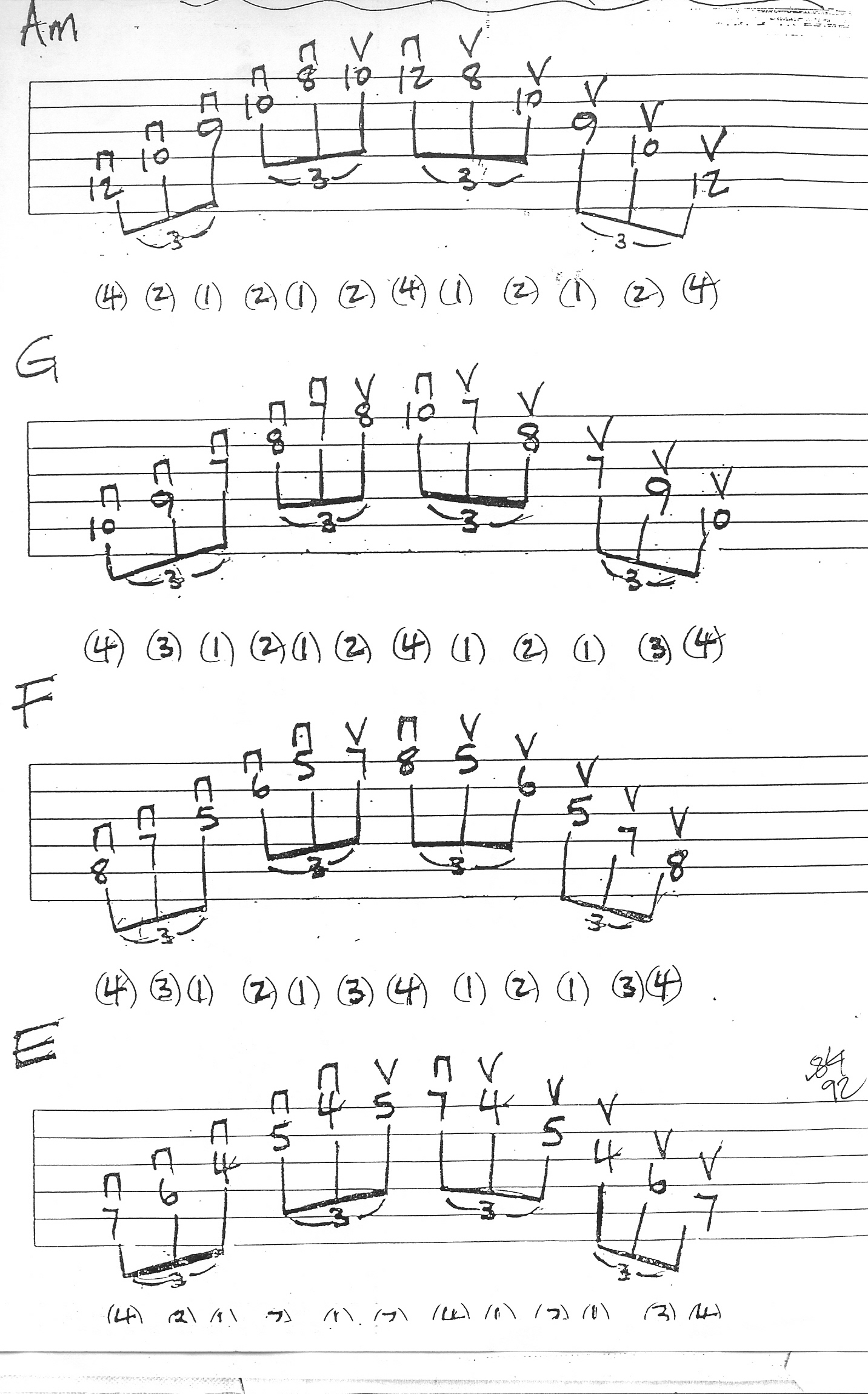
Arpeggios
Mastering the Art of Arpeggios on Guitar: The Beauty of Broken Chords
Arpeggios, often referred to as broken chords, are a fundamental aspect of guitar playing that add depth, texture, and complexity to your musical compositions. Whether you’re a beginner or an experienced guitarist, understanding how to play arpeggios can significantly enhance your skills and creativity. In this guide, we’ll explore the essence of arpeggios, focusing on major and minor triads, and delve into techniques to help you master them effectively.
Understanding Arpeggios
Arpeggios are essentially chords whose notes are played individually rather than simultaneously. This technique creates a flowing, melodic sound that can be incorporated into various musical styles, from classical to rock and everything in between. The most common types of arpeggios are major and minor triads, which consist of three notes: the root, third, and fifth.
Playing Major Triad Arpeggios
To play a major triad arpeggio, begin by identifying the root note of the chord. For example, if you’re playing a C major triad, the root note is C. Next, add the third and fifth notes of the C major scale, which are E and G respectively. Practice playing these three notes individually, starting from the lowest pitch and ascending to the highest. Experiment with different picking patterns and rhythms to add depth and variation to your arpeggios.
Playing Minor Triad Arpeggios
Minor triad arpeggios follow a similar pattern to major triads but with a minor third interval instead of a major third. For instance, the notes of a C minor triad are C (root), E♭ (minor third), and G (fifth). Practice playing these notes in succession, paying attention to the subtle difference in sound compared to major triads. Experiment with different fingerings and positions on the fretboard to explore the full range of possibilities.
Techniques for Mastering Arpeggios
- Sweep Picking: This technique involves using a fluid, sweeping motion with your picking hand to play consecutive notes on adjacent strings. Sweep picking is particularly useful for arpeggios as it allows for fast and smooth transitions between notes.
- Alternate Picking: Alternate picking involves alternating between downward and upward strokes with your picking hand. This technique is great for increasing speed and precision when playing arpeggios, especially at faster tempos.
- Hammer-ons and Pull-offs: Incorporating hammer-ons and pull-offs into your arpeggio patterns can add embellishments and fluidity to your playing. Experiment with adding these techniques between notes within the arpeggio shape to create dynamic and expressive melodies.
- Practice with a Metronome: Consistent practice with a metronome is essential for developing timing, accuracy, and muscle memory when playing arpeggios. Start slowly and gradually increase the tempo as you become more comfortable with the patterns.
Arpeggios are a versatile and essential tool for any guitarist looking to expand their musical vocabulary and expressiveness. By mastering major and minor triad arpeggios and incorporating various techniques into your playing, you can unlock a world of creative possibilities on the guitar. Remember to practice regularly, stay patient, and most importantly, have fun exploring the art of arpeggios.
Ready to elevate your guitar playing with arpeggios? Start practicing today and unlock new levels of musical expression!
Shredding with Arpeggios: The Ultimate Guide to Arpeggio Patterns for the Modern Guitarist
Arpeggios are not only essential for adding flair and complexity to your guitar solos but are also a hallmark of the modern shredding style. Mastering arpeggio patterns opens up a world of possibilities for guitarists, allowing for lightning-fast runs, impressive sweeps, and melodic improvisations. In this ultimate guide, we’ll explore arpeggio patterns tailored for the modern guitarist, providing techniques and insights to help you elevate your shredding skills to new heights.
Arpeggio Patterns
Arpeggio patterns are specific sequences of notes derived from chords, played individually in rapid succession. These patterns are characterized by their fluidity, precision, and speed, making them a favorite among shredders looking to showcase their technical prowess. While there are countless arpeggio patterns to explore, we’ll focus on a few essential shapes commonly used in modern guitar playing.
Essential Arpeggio Patterns
- Major and Minor Triads: These basic arpeggio patterns consist of three notes— the root, third, and fifth— arranged in various configurations across the fretboard. Experiment with different fingerings and positions to create fluid transitions between shapes.
- Seventh Chords: Seventh chord arpeggios add an extra layer of complexity with the inclusion of the seventh interval. Explore dominant, major, minor, and diminished seventh arpeggios to expand your harmonic vocabulary and add tension and resolution to your solos.
- Extended Arpeggios: Extended arpeggios incorporate additional chord tones beyond the basic triad, such as the ninth, eleventh, and thirteenth. These patterns offer a rich, sophisticated sound and are perfect for creating intricate melodies and harmonies.
Techniques for Mastering Arpeggio Shredding
- Economy Picking: Economy picking involves minimizing unnecessary motion with your picking hand to achieve maximum speed and efficiency. Practice economy picking patterns with arpeggios to streamline your technique and execute lightning-fast runs effortlessly.
- Legato Technique: Legato technique, including hammer-ons, pull-offs, and slides, is crucial for achieving smooth, fluid arpeggio runs. Focus on maintaining evenness and clarity between notes to create a seamless flow of sound.
- String Skipping: String skipping adds a dynamic element to your arpeggio playing, allowing you to navigate the fretboard with agility and creativity. Experiment with skipping strings within arpeggio patterns to create unexpected intervals and shapes.
- Modal Arpeggios: Incorporating modal arpeggios into your playing adds color and depth to your solos by highlighting the unique characteristics of different modes. Experiment with arpeggio patterns derived from modes such as Ionian, Dorian, Phrygian, and Lydian to explore a wide range of tonalities and moods.
Arpeggio shredding is a hallmark of modern guitar playing, showcasing technical proficiency, creativity, and musicality. By mastering essential arpeggio patterns and techniques, you can unlock a world of expressive possibilities on the guitar. Whether you’re aiming to shred at blistering speeds or add melodic sophistication to your solos, arpeggios are an indispensable tool for the modern guitarist.
Ready to take your shredding skills to the next level with arpeggios? Start practicing today and release your full potential as a modern guitarist!
While not all of these songs are known for their arpeggio-heavy guitar parts, some do incorporate arpeggios in their chord progressions or intros. Let’s take a look at how arpeggios are used in each song:
- R.E.M. – “Everybody Hurts”: The song features a simple chord progression, and while there aren’t prominent arpeggios throughout, the guitar part in the intro and verses does utilize arpeggios within the chord shapes, particularly in the picking pattern.
- “Street Spirit (Fade Out)” by Radiohead is known for its haunting atmosphere and melancholic melody. The guitar part in this song, played by Jonny Greenwood, features arpeggios that contribute to the song’s ethereal sound. Here’s how the arpeggios are used in “Street Spirit”:
- Intro: The song begins with a haunting arpeggiated guitar riff that sets the mood for the rest of the track. The arpeggios are played using delay and reverb effects, creating a sense of space and depth.
- Verse: Throughout the verses, the guitar continues to play arpeggios, providing a melodic accompaniment to Thom Yorke’s vocals. The arpeggios are played delicately, adding to the overall sense of melancholy and introspection.
- Chorus: The arpeggios become more pronounced during the chorus, building tension and intensity as the song progresses. The repetitive nature of the arpeggios reinforces the song’s hypnotic quality, drawing the listener in.
- Bridge: In the bridge section, the arpeggios take on a more dissonant quality, creating a sense of unease and tension. This contrasts with the softer, more melodic arpeggios heard earlier in the song, adding depth and complexity to the music.
Overall, the arpeggios in “Street Spirit (Fade Out)” play a crucial role in shaping the song’s atmosphere and emotional impact. They contribute to the sense of longing and despair that permeates the track, making it one of Radiohead’s most haunting and memorable songs.
While not all of these songs are arpeggio-heavy, some incorporate arpeggios in their guitar parts, either in the intros, verses, or as embellishments throughout the song. These arpeggios add depth, texture, and melody to the music, contributing to the overall atmosphere and emotional impact of each song.







